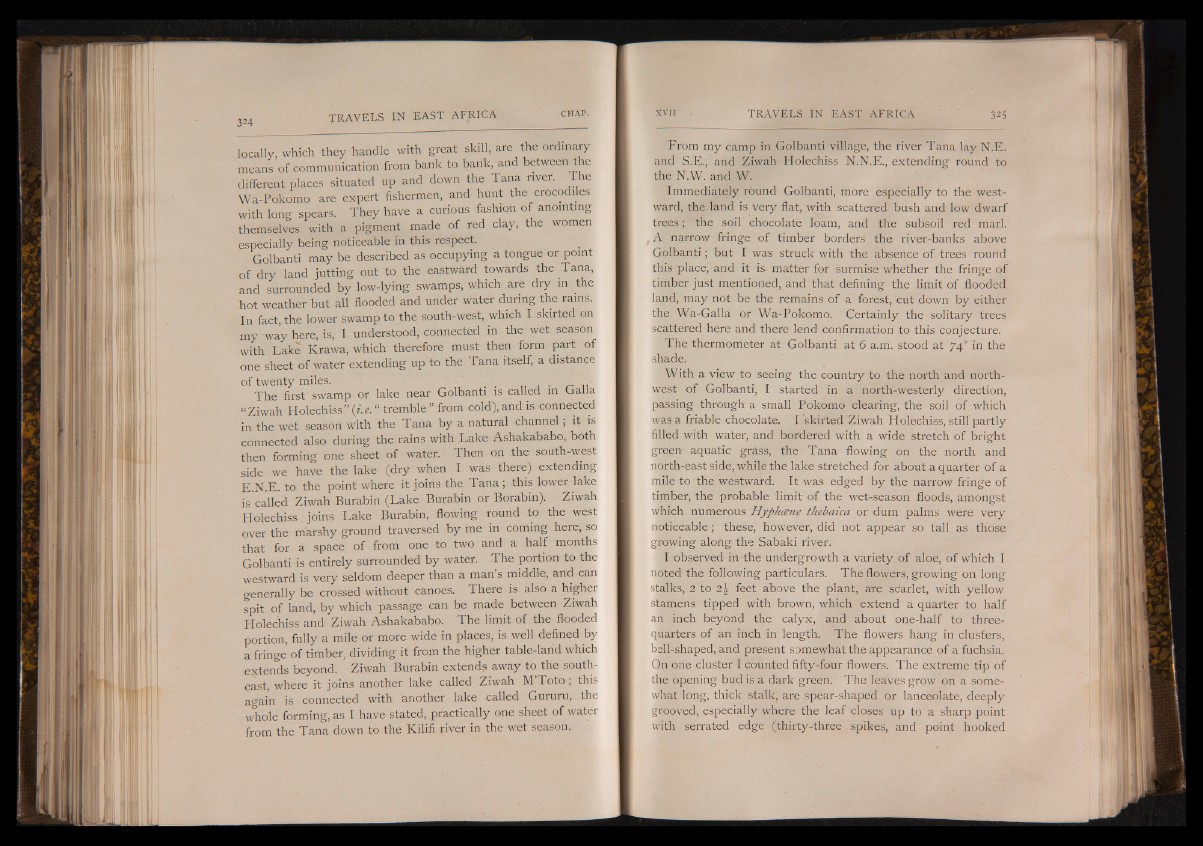
locally, which they handle with great skill, are the ordinary
means of communication from bank to bank, and between the
different places situated up and down the Tana river. T e
Wa-Pokomo are expert fishermen, and- hunt the crocodiles
with long spears. They have a curious fashion of anointing
themselves with a pigment made of red clay, the women
especially being noticeable in this respect.
Golbanti may be described as occupying a tongue or point
of dry land jutting out to the eastward towards the Tana,
and surrounded by low-lying swamps, which are dry in the
hot weather but all flooded and under water during the rains.
In fact, the lower swamp to the south-west, which I skirted on
my way here, is, I understood, connected in the wet season
with Lake Krawa, which therefore must then form part of
one sheet of water extending up to the Tana itself, a distance
of twenty miles. ' _ .
The first swamp or lake near Golbanti is called in Galla
“ Ziwah Holechiss” {i.e. I tremble ” from cold), and is connected
in the wet season with the Tana by a natural channel; it is
connected also during the rains with Lake Ashakababo, both
then forming one sheet of water. Then on the south-west
side we have the lake (dry when I was there) ■ extending
E.N.E. to the point where it joins the Tana ; this lower lake
is called Ziwah Burabin (Lake Burabin or Borabin). Ziwah
Holechiss joins Lake Burabin, flowing round to the west
over the marshy ground traversed by me in coming here, so
that for a space of from one to two and a half months
Golbanti is entirely surrounded by water. The portion to the
westward is very seldom deeper than a man s middle, and can
generally be crossed without canoes. There is also a higher
spit of land, by which passage can be made between Ziwah
Holechiss and Ziwah Ashakababo. The limit of the flooded
portion, fully a mile or more wide in places, is well defined by
a fringe of timber, dividing it from the higher table-land which
extends beyond. Ziwah Burabin extends away to the southeast,
where it joins another lake called Ziwah M’Toto ; this
again is connected with another lake called Gururu, the
whole forming, as I have stated, practically one sheet of water
from the Tana down to the Kilifi river in the wet season.
From my camp in Golbanti village, the river Tana lay N.E.
and S.E., and Ziwah Holechiss N.N.E., extending round to
the N.W. and W.
Immediately round Golbanti, more especially to the westward,
the land is very flat, with scattered bush and low dwarf
trees; the soil chocolate loam, and the subsoil red marl.
A narrow fringe of timber borders the river-banks above
Golbanti; but I was struck with the absence of trees round
this place, and it is- matter for surmise whether the fringe of
timber just mentioned, and that defining the limit of flooded
land, may n6t be the remains of a forest, cut down by either
the Wa-Galla or Wa-Pokomo. Certainly the solitary trees
scattered here and there lend confirmation to this conjecture.
The thermometer at Golbanti at 6 a.m. stood at 74° in the
shade.
With a view to seeing the country to the north and northwest
of Golbanti, I started in a north-westerly direction,
passing through a small Pokomo clearing, the soil of which
was a friable chocolate. I ‘skirted Ziwah Holechiss, still partly
filled with water, and bordered with a wide stretch of bright
green aquatic grass, the Tana flowing on the north and
north-east side, while the lake stretched for about a quarter of a
mile to the westward. It was edged by the narrow fringe of
timber, the probable limit of the wet-season floods, amongst
which numerous Hyphcene thebaica or dum palms were very
noticeable; these, however, did not appear so tall as those
growing along the Sabaki river.
I observed in the undergrowth a variety of aloe, of which I
noted the following particulars. The flowers, growing on long
stalks, 2 to 2\ feet above the plant, are sdarlet, with yellow
stamens tipped with brown, which extend a quarter to half
an inch beyond the calyx, and about one-half to three-
quarters of an inch in length. The flowers hang in clusters,
bell-shaped, and present somewhat the appearance of a fuchsia.
On one cluster I counted fifty-four flowers. The extreme tip of
the opening bud is a dark green. The leaves grow on a somewhat
long, thick stalk, are spear-shaped or lanceolate, deeply
grooved, especially where the leaf closes up to a sharp point
with serrated edge (thirty-three spikes, and point hooked